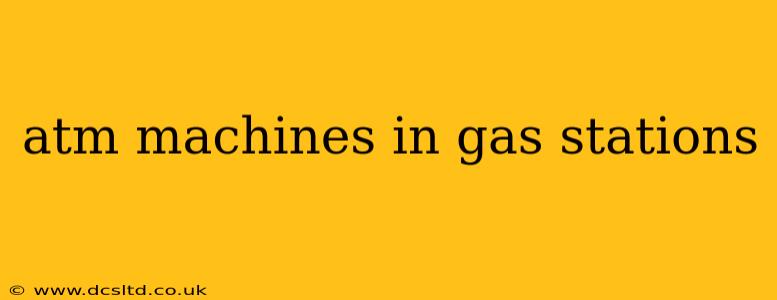Gas stations have become ubiquitous hubs of convenience, offering not only fuel but also snacks, drinks, and increasingly, ATM machines. The presence of ATMs at gas stations offers a significant benefit to consumers, but also presents considerations for both businesses and users regarding security and accessibility. This article will explore the prevalence of ATMs at gas stations, their benefits and drawbacks, and what the future might hold for this increasingly common pairing.
Why Are ATMs Located in Gas Stations?
The strategic placement of ATMs in gas stations is a mutually beneficial arrangement. For gas station owners, ATMs represent a supplementary revenue stream through transaction fees. For consumers, it provides readily available access to cash, especially in areas with limited banking options or during off-banking hours. The high foot traffic at gas stations ensures consistent use of the machines, making them a lucrative proposition for both parties involved.
Are ATMs in Gas Stations Safe?
This is a valid concern for many users. While gas stations themselves can be vulnerable to crime, modern ATMs are equipped with sophisticated security measures. These include:
- Surveillance cameras: Most ATMs are monitored by CCTV cameras, deterring potential criminals and aiding in investigations.
- Robust construction: ATMs are built to withstand physical attacks and tampering.
- Anti-skimming devices: These technologies help prevent the theft of card information.
- Regular maintenance and monitoring: Banks and ATM providers regularly service and monitor their machines for signs of tampering or malfunction.
However, exercising caution is always advised. Avoid using ATMs in poorly lit or isolated areas. Be aware of your surroundings and avoid using your ATM card if you feel unsafe.
What Are the Benefits of ATMs in Gas Stations?
The benefits are multifaceted:
- Convenience: 24/7 access to cash is a major draw, especially for those who need cash outside of typical banking hours or for emergencies.
- Accessibility: Gas stations are widely distributed, often located in areas with limited banking infrastructure.
- Increased foot traffic: The presence of an ATM can attract customers to the gas station who might not otherwise stop.
How Do ATMs in Gas Stations Work?
The operation is similar to any other ATM. Customers insert their debit or credit card, enter their PIN, and select their desired transaction. The machine dispenses cash, and the transaction is recorded by the bank. Gas station owners generally receive a commission from the bank for each transaction processed through their ATM.
What Happens if There's a Problem with the ATM in a Gas Station?
Most ATMs have contact numbers displayed on the screen for reporting problems. These issues could range from card jams to dispensing errors. Contacting the number displayed on the machine will usually connect you to the bank or ATM provider, who can resolve the issue.
Are ATMs in Gas Stations More Prone to Crime?
While gas stations are sometimes targeted for robberies, the security measures mentioned above significantly reduce the likelihood of successful ATM heists. The risk, however, is still present, and vigilance remains crucial for users.
What is the Future of ATMs in Gas Stations?
With the rise of contactless payments and digital wallets, the future of traditional ATMs remains to be seen. However, cash remains a preferred method for many, particularly for smaller transactions. We can anticipate continued evolution in ATM security and technology, and their continued presence in easily accessible locations like gas stations.
The convenience offered by ATMs in gas stations remains a significant benefit for both consumers and businesses. While security concerns exist, the measures implemented by ATM providers and gas stations mitigate these risks to a large extent. The future likely holds continued innovation in ATM technology and integration with other financial services, maintaining their vital role in our modern financial landscape.
